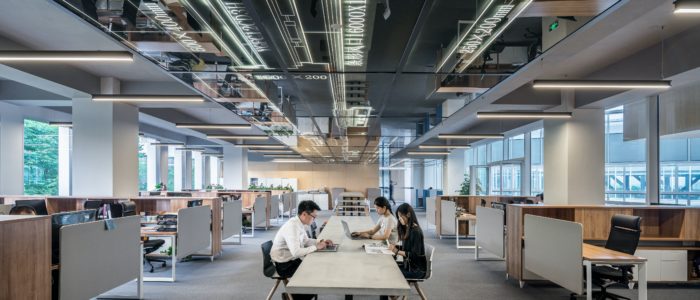
Critics Of Open Plan Offices Shift Their Focus To The Downside Of Virtual Meetings
Why can’t remote work replace the physical workplace altogether? According to an article in the Harvard Business Review cited by workplaceinsight.com,
“…Meetings are important, of course, but not more so than human moments, because it is relationships, not merely acts of collaboration, that create trust between coworkers. Studies have long shown that frequent in-person interactions lead to commitment, support, and cooperation among people on teams. That’s why many tech companies that boast about being 100% online still have an office. Even those that have no physical space emphasize that teams should meet face-to-face on a regular basis…”
Read more at:
https://workplaceinsight.net/well-at-least-nobody-is-whinging-about-open-plan-offices-anymore/

Office Metamorphosis from Physical to Virtual
John Seabrook has written an insightful article, published by the New Yorker, about the paradigm shift from physical offices to remote work and how companies may navigate these unchartered waters in the wake of the pandemic.
The writer poses a thought-provoking set of questions: “What’s an office for? Is it a place for newbies to learn from experienced colleagues? A way for bosses to oversee shirkers? A platform for collaboration? A source of friends and social life? A respite from the family? A reason to leave the house? It turns out that work, which is what the office was supposed to be for, is possible to do from somewhere else”.
In the digital world before the covid shift, the tools that were meant to improve communications in the workplace actually reduced the in person interactions that the open-plan office was supposed to enhance. Now the same tools make it possible to work remotely rather than wasting time online in the office. Surveys cited in the article show that employees actually worked harder from home during lockdown.
Expensive office space in prime markets has become a costly burden. The office has gradually evolved from high-to-low to no workstation panels, culminating in rows of desking systems. That proximity won’t do in the era of the pandemic. Conventional wisdom further evolved during the pandemic, championing the use of antimicrobial materials for high touch locations in the workplace and installation of plexiglass shields and signage promoting social distancing. Finally it became evident that the virus was more likely to spread through HVAC systems than through surface contact and that plexiglass would not slow the spread if the virus is circulating through the ventilation systems.
A VP at Microsoft interviewed by the writer explained that the pandemic is creating a “second digital transformation” by connecting employees’ computers through the cloud wherever they are working. Companies are investing money saved by downsizing physical offices, into cloud-based offices with digital whiteboards and virtual conferencing tools. One of the writer’s ironic conclusions is that the virtual office may eliminate privacy altogether, as every keystroke will be trackable.
Read the full article at:
https://www.newyorker.com/magazine/2021/02/01/has-the-pandemic-transformed-the-office-forever